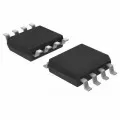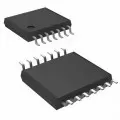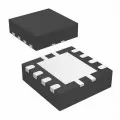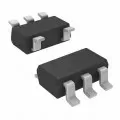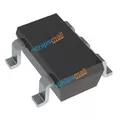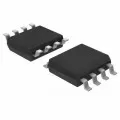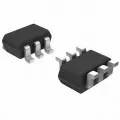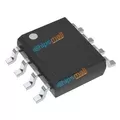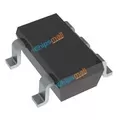OUTLINE:
PMIC Meaning: In-depth Analysis of Power Management Integrated Circuits
 399
399As we know, power management integrated circuits are widely applied in various electronic equipment. Yet there still exists some questions concerning what is a PMIC, with the help of this comprehensive guide, here is some basic information of this helpful component for your reference.
Quick Introduction: What Is A PMIC
PMIC is one kind of highly integrated circuit that integrates multiple power management functions, which is able to convert external power sources (such as batteries, power adapters, etc.) into the voltage and current required by the internal components of the device. For instance, PMIC can function like DC-DC converters, linear regulators, battery charge management, power sequencing, power monitoring, and equipment protection. Moreover, this kind of specially designed circuit ensures the stability and reliability of the power supply by monitoring and controlling voltage, current and temperature, while automatically adjusting the power management strategy according to different operating states of the devices to achieve high efficiency.
With the intellectualizatioan and miniaturization of electronic devices, the demand for PMIC will be increasing. In the coming future, PMIC will develop in the direction of higher integration energy efficiency and intelligence, and at the same time, with the development of new energy, Internet of Things and other relevant technologies, PMIC will have broader application prospects in new energy vehicles, smart grids, smart homes etc.
Different Types of PMIC
Power Management Integrated Circuits (PMIC) is the generic term of a variety of circuits, which can be further classified according to different functions, applications or designs. And here are some common types of PMIC listed below:
1. Power Converters
|
Power Converters |
|
|---|---|
|
DC-DC converter |
Converts one DC voltage to another DC voltage, including Buck (Buck), Boost (Boost), buck-boost (Buck) and Flyback (Flyback) types. |
|
AC-DC converter |
Converts alternating current to direct current, commonly found in power adapters and chargers. |
|
LDO (Low Voltage Difference Linear Regulator) |
A linear regulator that provides a stable output voltage for applications that are sensitive to noise or require high precision voltage. |
2. Battery Management ICs
|
Battery Management ICs |
|
|---|---|
|
Battery Charge Manager |
It is used to manage the charging process of the battery to ensure safe and efficient charging. |
|
Battery monitor |
Monitor the voltage, current and temperature of the battery to protect the battery from overcharge, overdischarge, overheating and other damage. |
|
Battery protection chip |
Provides over current, short circuit and over temperature protection to ensure battery safety. |
3. Power monitoring and protection
|
Power monitoring and protection |
|
|---|---|
|
Voltage detector |
Detects and monitors the system voltage to prevent device damage caused by abnormal voltage. |
|
Power sequencer |
Controls the power-on and power-off sequence of multiple power rails to ensure stable system startup and shutdown. |
4. Motor control and drive
|
Motor control and drive |
|
|---|---|
|
Motor drivers |
Used to control the start, stop, and speed regulation of motors, common in fan, pump, robotics, and automotive applications. |
|
LED Driver |
Used to drive and control the brightness and color of LED lights for a variety of lighting and display applications. |
5. Application-specific PMIC
|
Application-specific PMIC |
|
|---|---|
|
Automotion-grade PMIC |
Designed for automotive electronics to meet the high temperature, high reliability and electromagnetic compatibility requirements of automotive environments. |
|
Industrial grade PMIC |
Suitable for industrial environments with high reliability and wide operating temperature range. |
|
PMICs with embedded controller |
Integrated micro-controllers enable more complex power management and system control functions. |
As the tables shown above, there are many types of PMIC. When choosing the right PMIC, there is a need to consider the specific requirements of the application, including power efficiency, size limitations, cost, functional requirements, and environmental conditions. As technology continues to advance, PMIC's integration, efficiency and intelligence will continue to improve to meet the increasingly complex power management needs.
Working Principles Main Functions of PMIC
PMIC is a vital part of modern electronic equipment, whose working principles and main functions involve the generation, distribution, conversion and management of power to ensure that electronic systems can run stably and efficiently. The working principles and main functions of PMIC are described in detail below.
How it works
1. Voltage regulation and regulation
LDO (low voltage difference linear regulator) and other components provide voltage regulation output, even if the input voltage fluctuates, it can ensure the stability of the output voltage to meet the power supply needs of sensitive circuits.
2. Power conversion
The DC-DC converter inside the PMIC (buck, boost, lift, etc.) converts the input DC voltage to the voltage required for different components of the device. The AC-DC converter converts alternating current (AC) to direct current (DC) and is suitable for scenarios such as power adapters.
3. Power monitoring and protection
PMIC includes over-voltage, over-current, overheat protection mechanism, by monitoring the circuit status, in order to prevent equipment damage caused by abnormal power supply.
4. Battery management
In portable devices, PMIC is responsible for battery charge management, discharge control and condition monitoring to ensure the health and safety of the battery.
5. Power sequencing and control
PMIC can control the power-on sequence of multiple power rails to ensure the stability and safety of the system when starting or closing.
Main functions
1. Power conversion and regulation
The input power is converted to the different voltage levels required by the system to provide stable and clean power.
2. Battery management
PMIC has various functions of battery management, including charge management, discharge control, battery status monitoring (such as SOC, SOH), etc., to ensure the efficient use and safety of the battery.
3. Power monitoring
Real-time monitoring of power status, including voltage, current, temperature, etc., to ensure the stability and safety of the power supply.
4. System control
In some advanced PMIC, micro-controllers may be included to implement more complex power management and system control strategies.
5. Energy saving and efficiency
Through intelligent control, such as dynamic voltage regulation, load switching, etc., improve power efficiency, extend battery life, and reduce power consumption.
Characteristics Advantages of PMIC
PMIC (Power Management Integrated Circuits) plays a vital role in modern electronic systems with its unique characteristics and advantages.
Firstly, PMIC is highly integrated. It integrates a variety of power management functions on a single chip, such as DC-DC conversion, LDO voltage regulation, battery management, power monitoring, protection circuit, etc., greatly reducing the number of external components, simplifying circuit design, and reducing board level space.
Secondly, this kind of specially integrated circuit has higher efficiency and lower power cost than other similar products, for which PMIC applies advanced conversion technology and particular design, such as synchronous rectification and PWM control, to significantly improve power conversion efficiency, reduce power consumption, and extend battery life.
Thirdly, intelligent and adaptive control helps PMIC become smarter. Advanced PMIC contains micro-controllers or digital signal processors that enable intelligent power management such as dynamic voltage regulation, point of load (POL) control, and system-level power optimization to adapt to different workloads and environmental conditions.
Fourthly, reliability and protection mechanisms make PMIC popular on the electronic market. Over voltage, over current, over temperature, short circuits are simply worked out by the protection mechanism of PMIC, ensuring that the electronic system can operate safely under abnormal conditions and avoid hardware damage.
Fifthly, PMIC supports a variety of input and output voltage configurations, which can be configured through software parameters to adapt to different application requirements and improve the flexibility and versatility of the design.
Furthermore, with the development of semiconductor technology, the size of PMIC is continuously reduced, while maintaining or improving performance, suitable for portable devices and space-constrained electronic systems.
Last but not least, cost-effectiveness endows PMIC popularity and competitiveness to keep a foothold on the quickly-changing market. While a single PMIC may cost more than separate components, its high degree of integration reduces external component and PCB space, reducing overall system cost and complexity.
The characteristics of PMIC make it the preferred solution for power management in modern electronic devices, from smartphones to servers to electric vehicles, PMIC plays an integral role in ensuring the efficient and reliable operation of equipment.
Practical Applications of PMIC
PMIC has a wide range of applications, and its efficient, compact and intelligent characteristics make it an indispensable component in modern electronic equipment.
1. Consumer Electronics
|
Smartphones and tablets |
PMIC is responsible for managing battery charging, power distribution, LED backlight control, etc., to ensure that the device can operate efficiently and stably in different use scenarios. |
|
Wearable devices |
In devices with extremely limited space, the efficiency and miniaturization of PMIC is crucial for managing battery life and supporting functions such as wireless charging. |
|---|---|
|
Digital cameras and portable music players |
Provide stable power supply, optimize battery usage, and ensure device reliability and user experience. |
|
Laptops and desktops |
PMIC is used for power management and thermal control to optimize CPU, GPU and memory power consumption and improve energy efficiency. |
|
Servers and data centers |
In high-density computing environments, PMIC enables precise control and efficient conversion of power, reducing energy waste and supporting green computing. |
2. Automotive Electronics
|
Electric and hybrid vehicles |
PMIC plays a key role in the battery Management System (BMS), monitoring the status of the battery, managing the charging and discharging process, and improving energy efficiency. |
|
In-vehicle infotainment and Safety Systems |
Provides stable and secure power for automotive electronic systems, supporting multimedia, navigation and assisted driving functions. |
3. Industrial Automation
|
Factory Automation equipment |
PMIC provides reliable power management in industrial robots, sensor networks and control units, supporting high-precision operation. |
|
Power systems and smart grids |
In frequency converters, inverters and smart meters, PMIC implements power conversion and monitoring to improve the intelligence level of the grid. |
|---|
4. Internet of Things (IoT) devices
|
Sensor Networks |
PMIC optimizes energy use in low-power sensor nodes, prolongs device uptime, and supports remote monitoring and data acquisition. |
|---|---|
|
Smart Home |
Provides efficient power for smart bulbs, smart locks and security systems, supports wireless communication and remote control functions. |
5. Medical equipment
|
Portable medical devices |
Such as blood glucose meters, heart rate monitors, etc., PMIC ensures stable operation of devices in critical medical scenarios, supporting patient monitoring and data transmission. |
|---|---|
|
Large medical equipment |
In MRI and CT scanners, PMIC provides a highly stable power supply to ensure the accuracy and safety of the equipment. |
Final Verdict
PMIC is an indispensable component in the modern electronic circle, for which it provides stable and reliable power supply for various equipment and devices through intelligent and efficient power management, and is the guarantee of stable operation, efficiency and energy saving. With the continuous progress of future technology, PMIC will play an even more important role in more fields and construct a more intelligent and convenient home for users.

Disclaimer: The views and opinions expressed by individual authors or forum participants on this website do not represent the views and opinions of Chipsmall, nor do they represent Chipsmall's official policy.

share this blog to:


